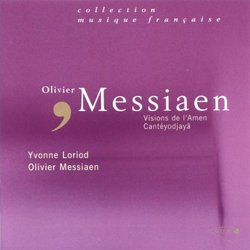| All Artists: Olivier Messiaen, Yvonne Loriod Title: Visions de l'Amen / Cantéyodjayâ Members Wishing: 0 Total Copies: 0 Label: Accord / Disques Adès Release Date: 10/30/2007 Album Type: Import Genre: Classical Style: Number of Discs: 1 SwapaCD Credits: 1 UPC: 028946579121 |
Search - Olivier Messiaen, Yvonne Loriod :: Visions de l'Amen / Cantéyodjayâ
CD Details |
CD ReviewsMessiaen Plays His Musical Canvas Of Creation Charles Andrew Whitehead | Fort Worth, Texas | 04/29/2008 (5 out of 5 stars) "Aside from being a major 20th Century composer, Olivier Messiaen was a wonderful performer who left us some treasured interpretations of his own organ music (including La Nativite du Seigneur and Messe du la Pentecote), piano pieces (the 4 Etudes du Rhythme), chamber music (Quartet) and Melodies (accompanying Bunlet in the Harawi cycle). His own realizations of the sound-world he created reveal an uncompromising imagination as he projects his musical and extra-musical ideas. Because of the early recording technology you are sometimes forced to conceptualize how things might have sounded in ideal circumstances, but this can actually be a greater aid in coming to terms with the infinite quality of his music. Those who search for a definitive reading of Visions de l'Amen will seek in vain, but with Olivier and Yvonne as our guides we are led through this cycle of 7 pieces never losing an overall narrative thread of the exalted awe of Creation.
Visions de l'Amen- a grand 45 minute work of 7 "Visions" for 2 pianos that expresses the scope and imagery of 4 separate definitions of the word "Amen"- was composed in 1943 for Messiaen and Yvonne Loriod (his new student, then 19), premiered in Paris with less than 2 months rehearsal that same year, and first recorded by them in 1949 (reissued in 2007 in French EMI's Les rarissimes series). Knowing already their individual qualities, Messiaen composed the second piano part for himself, laying down the pacing and emotional drive of the music while Ms. Loriod's strengths gave the first piano part its whirlwind virtuosity in the complex rhythmic canons and modal chord cascades. The couple were eventually married in 1961 and this recording was made the following year- an appropriate consummation of a partnership in life as well as music. The playing reflects this in every way and leaves little to be desired. The cosmos and timelessness in space are wonderfully caught in the dynamic layering of sonorities, timbres and rhythms in the first piece ("Amen" of Creation). The playing never strains in the majestic imagery as this slow, gradual crescendo unfolds and eventually comes to an abrupt end. The dramatic contrast between this and the next piece is very effectively handled. Only in the second and fifth pieces (Amen of the Stars and Ringed Planet and Amen of Angels, Saints and Birdsong) do I occasionally want for a little more forward motion, assertion or elemental fury, but their total reading is so organic- despite a few audible edits for the careful listener- and the Amen of Desir is as transcendentally serene and majestic as you could imagine. (Messiaen defines "desire" in a higher spiritual sense.) The explicit programmatic content of the tormented third piece (Amen of Jesus' Agony from the 7 Last Words) juxtaposes and recapitulates material that the performers must place in a narrative flow. This performance sweeps you along and you sense the environment changed when themes return, transformed. The transforming of themes, contrasts of mood in juxtaposed material and the building of tension to the dramatic silence seem to be very Romantic gestures- almost Lisztian in vein, although Stockhausen would later use extreme dramatic silences in his Klavierstuck X. Contrasting materials are also linked together in the Amen of the Angels, Saints and Birdsong with its elements of chant, birdsong and rhythmic canon and it occasionally bears a surface resemblance to Stravinsky or Debussy in more than just the juxtaposition of material. Messiaen's experience as an organist is clearly put to good use in the last piece- the Amen of Consummation. After peals of chordal bells the Creation theme returns chorale-like- as in the pedals of an organ before the music dances joyously towards its exalted conclusion. In short, an ecstatic ensemble performance of an awesome 20th Century composition. This CD is rounded out with Loriod's performance of Messiaen's Canteyodjaya, a 12 minute piano solo composed at Tanglewood, Massachusetts in 1948- the year following the Turangalila Symphony. It seems to synthesize many aspects of Messiaen's style but abandons earlier references to tonality and his favorite chord with the added 6th. Essentially a study in rhythm with use of 6-part canon and palindromic rhythm, the work has a conciseness and joyful energy and builds with irresistable excitement to the final climax. The piece is also notable for being the first music to use a mode of durations, pitches and dynamics but it so artfully combines the intellectual with the emotional, and the complex with the profoundly immediate. Loriod has the full breadth of the piece and draws out the contrasts with ease while holding the entire piece together. The Visions de l'Amen are well worth getting to know, predating the better known Vingt Regards and usable in whole or part in churches who are open-minded enough for spiritual contemplation of a deeper sort (and have 2 pianos!). " |

